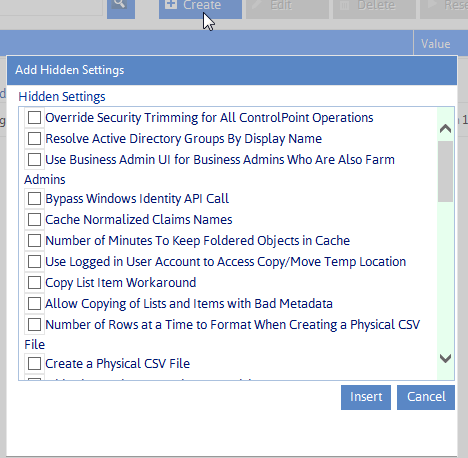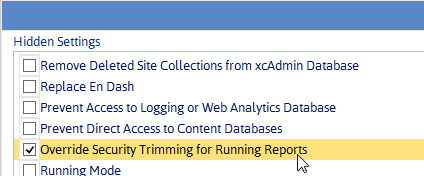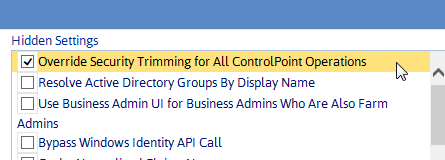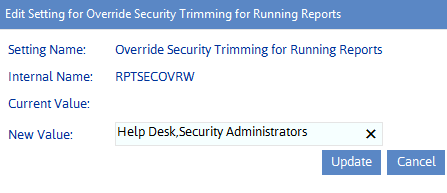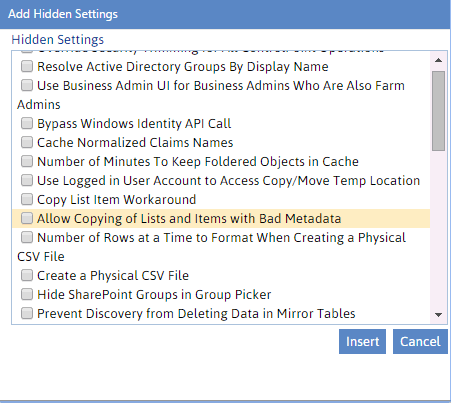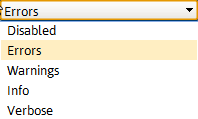Created (Hidden) Settings
"Created" settings are special-purpose settings that you can add to the ControlPoint Settings list if needed. Generally, these settings should only be configured under special circumstances and with guidance from Quest Support.
NOTE: When a setting is created, it is added to the category Special Purpose.
To create a ControlPoint Setting:
1From the ControlPoint Configuration Settings Manager, click [Create].
2Check the box to the left of each setting you want to create.
3Click [Insert].
To delete a Created setting:
NOTE: You can only delete settings that are classified as "Created." (That is, Basic and Advanced settings cannot be deleted.)
1In the ControlPoint Settings list, check the box to the left of each created setting you want to delete.
2Click [Delete].
When you delete a Created setting, it is removed from the current ControlPoint Settings list and once again becomes available from the Add Created Settings list.
Created Settings to Override ControlPoint Default Security
By default, ControlPoint is security trimmed to enforce SharePoint permissions. ControlPoint Application Administrators can, however, override these permissions to allow user groups that have been defined in the ControlPoint Configuration site to perform ControlPoint analyses and/or actions on site collections and sites for which they do not have management permissions.
You can use security overrides in conjunction with Customizing ControlPoint Menus to tailor your ControlPoint environment to best suit the needs of your organization.
NOTE: These settings do not override a user's permissions for the SharePoint sites themselves. (For example, it will not give a user permission to open a SharePoint site or make changes via SharePoint site settings pages if they have not been granted permissions to do so in SharePoint. Nor will a user who does not have permissions for Central Administration be able to use ControlPoint menu items that directly invoke Central Administration pages.)
To add security override to ControlPoint
NOTE: Because the use of security overrides should involve careful consideration and planning, they are createable (hidden) settings.
1From the ControlPoint Configuration Settings Manager, click [Create] .
2Use the information in the following to determine the appropriate action to take
|
If you want to ... |
Choose ... |
|---|---|
|
allow members of one or more ControlPoint user groups to perform data analyses for any site collection or site in the farm |
Override Security Trimming for Running Reports. |
|
allow members of one or more ControlPoint user groups to perform ControlPoint actions and analyses on any site collection/site in the farm |
Override Security Trimming for All ControlPoint Operations. CAUTION: Because implications of taking actions are much more significant than viewing data, it is recommended that ControlPoint Application Administrators use extreme care when configuring this setting. (Remember that you can also customize ControlPoint menus to give groups of users access to a subset of actions. See Guidelines for Creating Customized Menus for Different Groups of Users.) |
3Navigate to the new setting and open it for editing.
4For New Value, enter the name of each ControlPoint group whose security trimming you want to override.
NOTE: If you want to extend this privilege to more than one group, enter the group names in a comma-separated list (with no spaces between group names). If you want to extend it to all ControlPoint groups, enter ALL.
Additional Created Settings
Because of potential environmental implications, the majority of "created" settings should be configured only under special circumstances and with guidance from Quest Support.
Changing Trace Switch Logging Levels
ControlPoint contains a number of trace switches that control the type and level of detail that is captured in the ControlPoint Administration (xcAdmin) log. Quest Support may suggest that one or more of these be changed for diagnosis and troubleshooting purposes.
NOTE Trace switches are Advanced settings.
Valid values for all trace switches, listed from least to most detail, are:
·Disabled
·Error (the default)
·Warnings
·Info
·Verbose
Note that as the logging level increases, the amount of detail is "additive." For example, if you select the logging level Info, then Errors and Warnings will also be included.
|
If you want to change the logging level for... |
Edit the following setting ... |
|---|---|
|
the SharePoint hierarchy building for navigation and selection |
SharePoint Hierarchy Access Logging |
|
the amount of time it takes the SharePoint Hierarchy to load |
SharePoint Hierarchy Load Time Logging |
|
reports and actions general processing |
Traverse Entry Logging |
|
Additional Traverse Entry Logging | |
|
the interaction between ControlPoint and databases |
Database Interaction Logging |
|
the validation of SharePoint users by ControlPoint |
SharePoint Access Logging |
|
aspx page major events |
aspx Page Major Event Logging |
|
the interaction between ControlPoint and Active Directory |
Active Directory Interactions Logging |
|
operations performed by the ControlPoint Scheduler |
ControlPoint Scheduler Logging |
|
the management of linked SharePoint groups |
Manage Linked SharePoint Group Logging |
|
WCF Services calls |
WCF Service Call Logging |
|
ControlPoint Policies and Site Provisioning operations |
ControlPoint Policies Logging |
|
copy/move at set site properties operations |
Copy/Move and Set Site Properties Logging |
|
non-specific events |
Non-Specific Event Logging |
|
Audit Log archiving |
Audit Log Archive Logging |
|
Workflow reporting for the Comprehensive User Analysis |
Comprehensive User Workflow Report Logging |
|
access to the Managed Metadata Service Application database |
Managed Metadata Service Application Database Access Logging |
|
ControlPoint operations performed via PowerShell |
PowerShell Processing Logging |
|
Set List properties operations |
Set List Properties Logging |
|
Social Activity Analysis processing |
Social Activity Analysis Logging |
|
ControlPoint Statistics Lists calculations |
Statistics Lists Calculation Logging |
|
the ControlPoint Database Recovery operation |
ControlPoint Database Recovery Logging |

